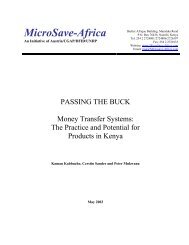You also want an ePaper? Increase the reach of your titles
YUMPU automatically turns print PDFs into web optimized ePapers that Google loves.
Award Winners<br />
In 2006, <strong>DAI</strong> was named Greater Washington Government<br />
Contractor <strong>of</strong> the Year (large contractor category) in the<br />
annual GovCon awards. The awards, affectionately known<br />
as the “Oscars” <strong>of</strong> government contracting, are presented<br />
annually by the Northern Virginia Government Contractors<br />
Council, the Pr<strong>of</strong>essional Services Council, and Washington<br />
Technology magazine. Two <strong>years</strong> later, Tony Barclay was<br />
individually honored by the same group as Executive <strong>of</strong> the<br />
Year. Typically, Barclay shared the honor with his colleagues,<br />
insisting that “this award really belongs to my fellow employee<br />
owners at <strong>DAI</strong>.”<br />
98<br />
Cindy Limoges, and Jean Gilson, who handled project management,<br />
new business acquisition, finance, human resources,<br />
and strategy and marketing, respectively. The reorganization<br />
helped remedy the disconnect between the home <strong>of</strong>fice<br />
and the field as well. For every project team, the Bethesda<br />
home <strong>of</strong>fice set up its own task force dedicated to achieving<br />
a seamless interface between the field and the back <strong>of</strong>fice. To<br />
oversee all <strong>of</strong> this, Boomgard appointed Betsy Marcotte as<br />
Senior VP for Operations.<br />
Many Faces, One Company<br />
Even as <strong>DAI</strong> pulled itself together into a more coherent business,<br />
the dynamics <strong>of</strong> the development arena gave rise to<br />
additional practice areas and new global <strong>of</strong>fices—new faces<br />
and new interfaces in an increasingly complex development<br />
world. One practice area grew from two initiatives spanning a<br />
10-year period. By the late 1990s, <strong>DAI</strong> teams had witnessed<br />
the social and economic cost <strong>of</strong> HIV/AIDS for <strong>years</strong>. Specialists<br />
still considered it a public health problem, something for<br />
doctors rather than development pr<strong>of</strong>essionals. But a few<br />
pr<strong>of</strong>essionals at <strong>DAI</strong> were convinced that it was something<br />
more. In 2001, Joan Parker and a few colleagues created<br />
an HIV/AIDS Response Team, dubbed H/ART, to provide<br />
targeted economic assistance to families and communities<br />
seeking to build back lives battered by the disease. While the<br />
H/ART team was able to integrate into broader development<br />
efforts in such threatened areas as Africa and Haiti, direct<br />
support from donor agencies was hard to obtain. “We were<br />
early movers when there was no market,” recalled Barclay.<br />
That began to change in 2003 with the creation <strong>of</strong> PEPFAR,<br />
and although the emphasis remained on doctors and drugs,<br />
more attention was gradually paid to the social context <strong>of</strong><br />
AIDS. PEPFAR cracked a door that <strong>DAI</strong> pushed open. During



